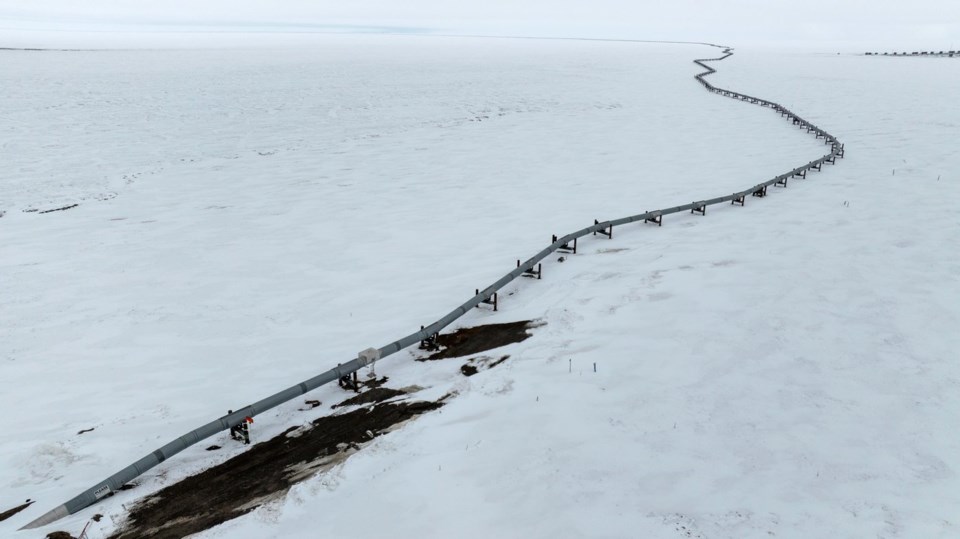DEADHORSE, Alaska (AP) — President Donald Trump wants to double the amount of oil coursing through Alaska's vast pipeline system and build a massive natural gas project as its “big, beautiful twin,” a top administration official said Monday while touring a prolific oil field near the Arctic Ocean.
The remarks by U.S. Energy Secretary Chris Wright came as he and two other Trump Cabinet members — Interior Secretary Doug Burgum and Environmental Protection Agency Administrator Lee Zeldin — visited Prudhoe Bay as part of a multiday trip aimed at highlighting Trump’s push to expand oil and gas drilling, mining and logging in the state that drew criticism from environmentalists.
During the trip, Burgum’s agency announced plans to repeal Biden-era restrictions on future leasing and industrial development in portions of the National Petroleum Reserve-Alaska that are designated as special for their wildlife, subsistence or other values.
The petroleum reserve is west of Prudhoe Bay and Deadhorse, the industrial encampment near the starting point of the trans-Alaska pipeline system. The pipeline, which runs for 800 miles (nearly 1,300 kilometers), has been Alaska’s economic lifeline for nearly 50 years.
Government and industry representatives from several Asian countries, including Japan, South Korea, Taiwan and the Philippines, were joining a portion of the U.S. officials’ trip, as Trump has focused renewed attention on the gas project proposal, which in its current iteration would provide gas to Alaska residents and ship liquefied natural gas overseas. Matsuo Takehiko, vice minister for International Affairs at Japan's Ministry of Economy, Trade and Industry, was among those at Prudhoe Bay on Monday.
For years, state leaders have dreamed of such a project but cost concerns, shifts in direction, competition and questions about economic feasibility have hindered progress. U.S. tariff talks with Asian countries have been seen as possible leverage for the Trump administration to secure investments in the proposed gas project.
Oil and natural gas are in significant demand worldwide, Wright told a group of officials and pipeline employees in safety hats and vests who gathered near the oil pipeline on a blustery day with 13-degree Fahrenheit (-10 Celsius) windchills. The pipeline stretched out over the snow-covered landscape.
“You have the big two right here," he said. “Let’s double oil production, build the big, beautiful twin, and we will help energize the world and we will strengthen our country and strengthen our families.”
Oil flow through the trans-Alaska pipeline peaked at about 2 million barrels in the late 1980s. In 2011 — a year in which an average of about 583,000 barrels of oil a day flowed through the pipeline, then-Gov. Sean Parnell, a Republican, set a goal of boosting that number to 1 million barrels a day within a decade. It's never come close in the years since: last year, throughput averaged about 465,000 barrels a day.
Those joining the Trump officials Monday included U.S. Sen. Dan Sullivan and Gov. Mike Dunleavy, both Republicans, who also took part in meetings Sunday in Anchorage and Utqiagvik.
In Utqiagvik, an Arctic community that experiences 24 hours of daylight this time of year, many Alaska Native leaders support Trump’s push for more drilling in the petroleum reserve and to open the Arctic National Wildlife Refuge to oil development. They lauded the visit after lamenting that they felt ignored by former President Joe Biden’s administration.
Alaska political leaders have long complained about perceived federal overreach by the U.S. government, which oversees about 60% of lands in Alaska. Sullivan, Dunleavy and Alaska's senior U.S. senator, Lisa Murkowski, often complained that Biden's team was too restrictive in its approach to many resource development issues.
Murkowski, an at-times vocal critic of Trump, joined for Sunday's meeting in Anchorage, where she said Alaska leaders “want to partner with you. We want to be that equal at the table instead of an afterthought.”
Environmentalists criticized Interior's planned rollback of restrictions in portions of the petroleum reserve. While Sullivan called the repeal a top priority, saying Congress intended to have development in the petroleum reserve, environmentalists maintain that the law balances allowances for oil drilling with a need to provide protections for sensitive areas and decried Interior's plans as wrong-headed.
Erik Grafe, an attorney with Earthjustice, called the Trump administration's intense focus on oil and gas troubling, particularly in a state experiencing the real-time impacts of climate change. He called the continued pursuit of fossil fuel development “very frustrating and heartbreaking to see.”
The Interior Department said it will accept public comment on the planned repeal.
The three Trump officials also plan to speak at Dunleavy's annual energy conference Tuesday in Anchorage.
____
Bohrer reported from Juneau, Alaska.
Becky Bohrer And Mark Thiessen, The Associated Press



